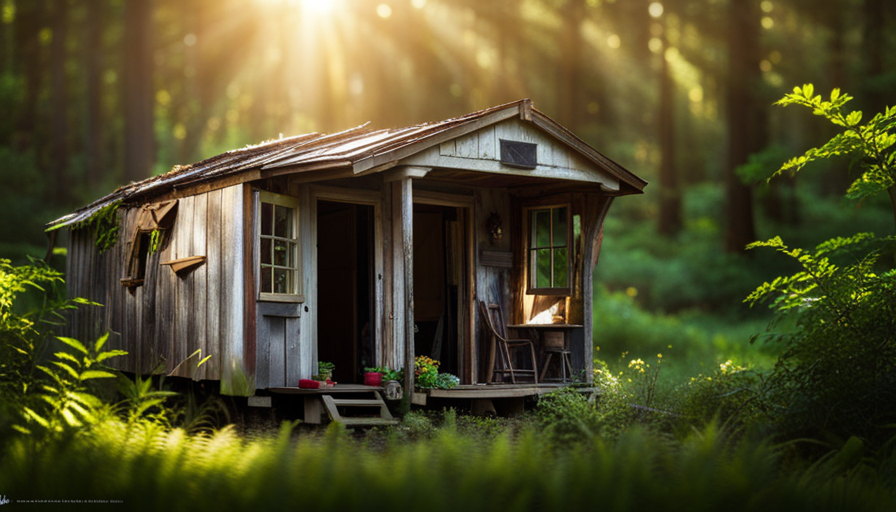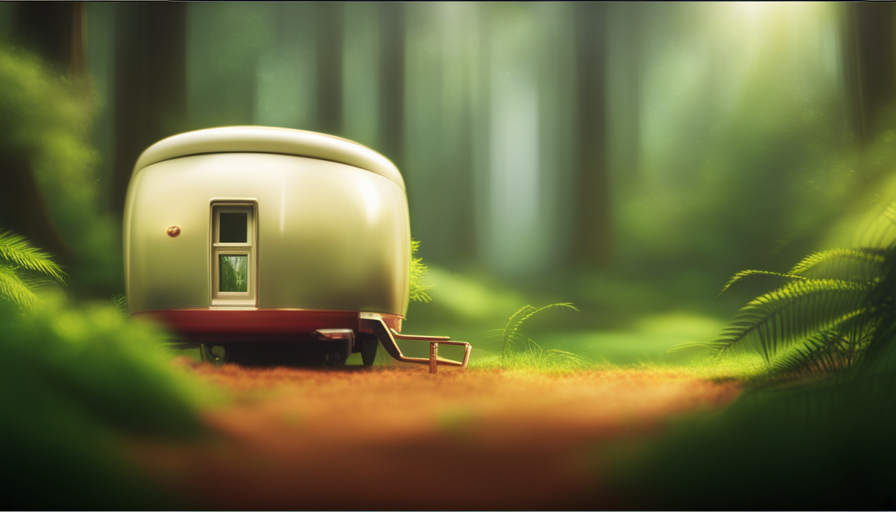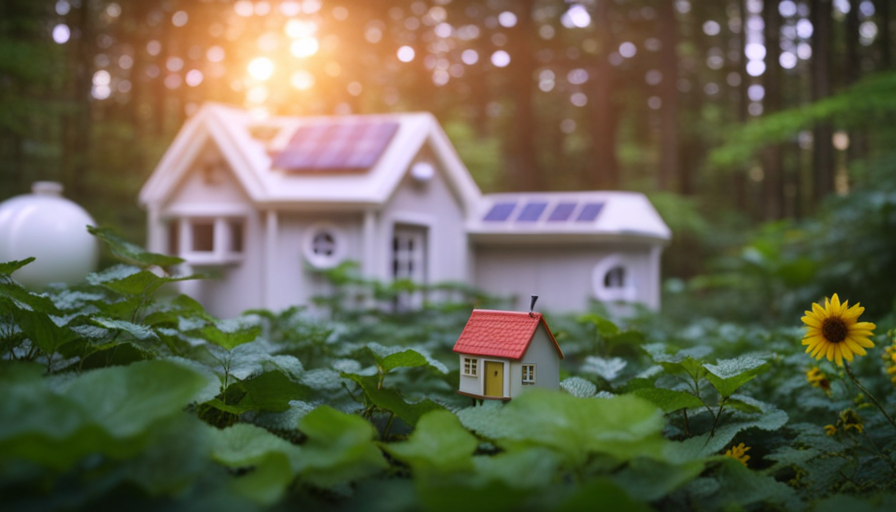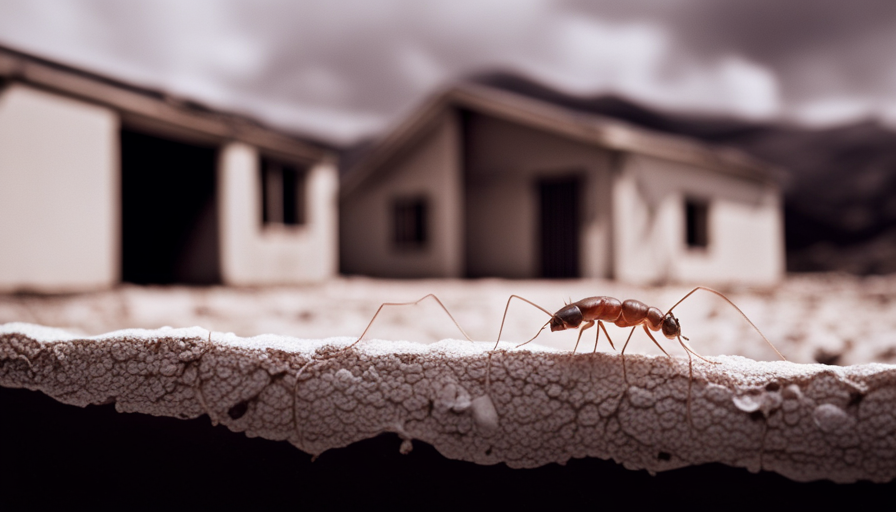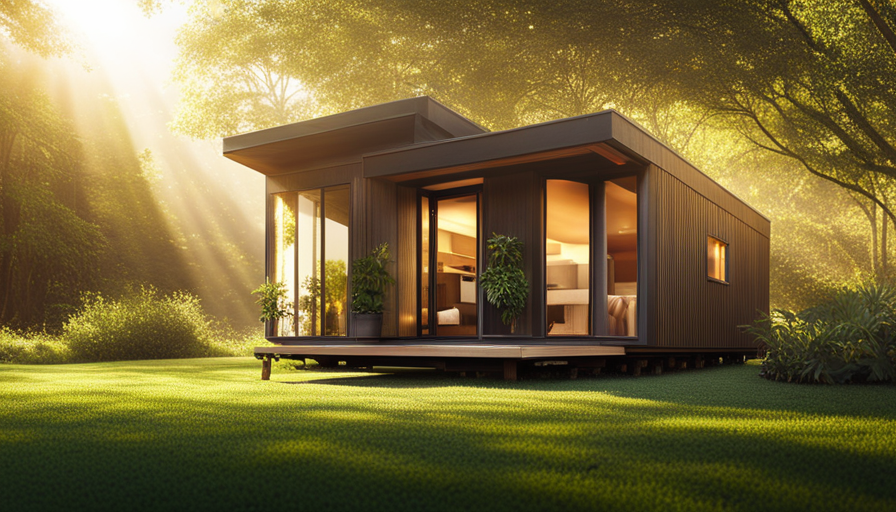Similar to a healthy young plant flourishing in fertile soil, a tiny home embodies resilience and sustainability. It serves as a testament to the endless possibilities of a minimalist lifestyle. However, one cannot help but wonder: How long can this small haven withstand the test of time?
In this article, we will delve into the factors that determine the lifespan of a tiny house, exploring the intricate web of construction materials, maintenance practices, and environmental conditions that shape its longevity. From the foundation that anchors its very existence to the adaptability that ensures its relevance for years to come, we will unravel the secrets behind the endurance of these diminutive dwellings.
Join me as we embark on a journey to understand the intricate tapestry that weaves together the lifespan of a tiny house, and discover the hidden potential that lies within these humble abodes.
Key Takeaways
- Factors that determine the lifespan of a tiny house include construction materials, maintenance practices, and environmental conditions.
- Sustainable building practices and cost-effective materials increase the durability of a tiny house.
- Regular maintenance and upkeep, including addressing repairs promptly, are vital for preserving the longevity of a tiny house.
- Proper construction techniques, insulation, ventilation, and foundation reinforcement ensure the structural integrity of a tiny house.
Construction Materials and Techniques
You’ll be amazed by the longevity of a tiny house when you use high-quality construction materials and techniques. Sustainable building practices and cost-effective materials are key factors in ensuring the durability of a tiny house.
By incorporating sustainable building practices, such as using recycled materials or installing energy-efficient systems, you can reduce the environmental impact of your tiny house while also increasing its lifespan.
Choosing cost-effective materials is also crucial in extending the longevity of a tiny house. Opting for materials that are durable, low-maintenance, and resistant to wear and tear will help your tiny house withstand the test of time. For example, using composite siding instead of traditional wood siding can provide better protection against rot and pests, ultimately increasing the lifespan of your tiny house.
Additionally, employing proper construction techniques is essential in ensuring the structural integrity of a tiny house. This includes using appropriate insulation, ensuring proper ventilation, and reinforcing the foundation. By following these techniques, you can prevent common issues like mold growth, moisture damage, and structural instability.
Regular maintenance and upkeep are also vital in preserving the longevity of a tiny house. Performing routine inspections, addressing any repairs promptly, and keeping up with general maintenance tasks will help prevent minor issues from turning into major problems.
Using sustainable building practices and cost-effective materials, along with employing proper construction techniques, can significantly increase the lifespan of a tiny house. However, regular maintenance and upkeep are equally important to ensure its longevity.
Regular Maintenance and Upkeep
With regular maintenance and upkeep, keeping your compact abode in shipshape condition is like tending to a delicate bonsai tree, nurturing it to thrive for years to come. Regular maintenance is crucial for the longevity of a tiny house.
By implementing a routine maintenance schedule, you can address potential issues before they become major problems. This includes inspecting the exterior for any signs of wear and tear, such as cracks or leaks, and promptly repairing them. Additionally, regular cleaning and treating of the exterior surfaces can help prevent damage caused by dirt, mold, or pests.
Preventive care is also essential in extending the lifespan of a tiny house. This involves implementing measures to protect the structure from common issues such as moisture damage, insect infestations, and structural deterioration. Applying weather-resistant coatings, installing proper insulation, and ensuring adequate ventilation are all important steps in preventing these issues from occurring.
By regularly maintaining and taking preventive measures, your tiny house can withstand various climate and weather conditions.
In the next section, we’ll explore how the durability of construction materials and techniques, combined with proper maintenance, can help tiny houses endure the challenges posed by different climates and weather conditions.
Climate and Weather Conditions
Experience the exhilarating power of nature as your compact abode effortlessly weathers the storms and embraces the changing seasons. Living in a tiny house exposes you to the elements in a way that traditional homes don’t. However, with proper design and construction, these homes can withstand the challenges posed by climate change and extreme temperatures.
Here are a few key factors to consider:
-
Insulation: Adequate insulation is crucial in maintaining a comfortable temperature inside your tiny house. It helps in regulating heat during scorching summers and chilly winters.
-
Ventilation: Proper airflow prevents moisture buildup, which can lead to mold and other issues. Well-designed windows and ventilation systems ensure a healthy and pleasant living environment.
-
Roofing: A durable and weather-resistant roof is essential to protect your tiny house from heavy rain, snow, and intense sunlight.
-
Exterior materials: Choosing weather-resistant materials, such as vinyl siding or metal cladding, can enhance the longevity of your tiny house by withstanding harsh weather conditions.
Climate change and extreme temperatures present challenges that require careful consideration during the design and construction of your tiny house. Addressing these factors will ensure that your compact abode remains resilient and comfortable for years to come.
Now, let’s delve into the next section about foundation and structural stability.
Foundation and Structural Stability
To ensure your compact abode stands the test of time, it’s important to lay a solid foundation and build a structurally stable tiny house. The foundation of a tiny house plays a crucial role in its overall durability and longevity. A strong foundation provides stability and prevents the house from shifting or settling over time. It is essential to choose a foundation type that suits your specific location and soil conditions. Common options include concrete slabs, pier and beam foundations, or even mobile foundations like trailers. Regardless of the type chosen, the foundation should be designed and built to withstand the weight and load of the tiny house.
In addition to the foundation, the structural integrity of the tiny house is equally important. The materials used and the construction techniques employed should be of high quality to ensure the house can withstand various environmental factors. From extreme weather conditions to regular wear and tear, a structurally stable tiny house will be able to withstand it all. It’s advisable to consult with professionals who specialize in tiny house construction to ensure the structural integrity of your home.
As we move into the next section about ‘usage and occupancy’, it’s important to understand how the foundation and structural stability impact the overall functionality and safety of your tiny house.
Usage and Occupancy
When you live in a compact abode, it’s important to consider how you will use and occupy the space to make it truly your own. Usage patterns and wear and tear are key factors that determine the lifespan of a tiny house. The way you utilize the space and the frequency of occupancy can have a significant impact on its longevity.
Tiny houses are designed to maximize every inch of available space, so it’s crucial to have a clear idea of your needs and how you plan to use the different areas within the house. This includes determining the functionality of each room, such as whether it will be a bedroom, a kitchen, or a multipurpose space. By understanding your usage patterns, you can ensure that the layout and design of the tiny house meet your specific requirements.
Additionally, the wear and tear on a tiny house can be influenced by the number of occupants and their daily routines. Constant foot traffic, cooking, and other activities can take a toll on the materials and systems within the house. Regular maintenance and careful use of appliances and fixtures can help mitigate the effects of wear and tear.
Considering these factors, it’s important to strike a balance between functionality and durability when using and occupying a tiny house. By being mindful of your usage patterns and taking preventive measures to minimize wear and tear, you can extend the lifespan of your tiny house.
Transitioning to the next section about ‘location and surroundings’, it is also essential to consider how the external factors impact the longevity of a tiny house.
Location and Surroundings
When it comes to choosing the location for your tiny house, it’s important to consider its exposure to natural elements such as weather and climate conditions. Living in an area with extreme temperatures, high humidity, or frequent storms can have a significant impact on the durability and longevity of your tiny house.
Additionally, proximity to potential hazards such as flood-prone areas, wildfire zones, or areas at risk of landslides should also be taken into account to ensure the safety and long-term viability of your tiny house.
It’s crucial to thoroughly research and assess these factors before deciding on the location and surroundings for your tiny house.
Exposure to Natural Elements
Exposed to the harsh elements, a tiny house can weather the storm like a sturdy oak tree, standing strong for decades. Weather resistance is a key factor in determining how long a tiny house can last. These compact dwellings are designed to withstand extreme weather conditions, such as heavy rain, strong winds, and even snowstorms.
Built with durable materials and reinforced structures, tiny houses are equipped to handle the wear and tear that comes with exposure to natural elements. From sturdy roofs to well-insulated walls, every aspect of a tiny house is carefully constructed to ensure long-lasting durability.
In addition to weather resistance, the location and surroundings of a tiny house play a crucial role in its longevity. Proximity to potential hazards, such as flood-prone areas or areas prone to wildfires, can pose a threat to the lifespan of a tiny house. Therefore, it’s important to choose a location that minimizes the risk of damage from natural disasters.
Proximity to Potential Hazards
To ensure the safety and security of your tiny home, it’s crucial to carefully consider the potential hazards in the surrounding area. Living in a tiny house means being aware of the potential risks that could affect its stability and longevity. Here are some safety measures to keep in mind:
-
Weather conditions: Excessive heat, heavy rain, or strong winds can put your tiny home at risk. Ensure proper insulation, sturdy construction, and storm-resistant materials.
-
Fire hazards: Proximity to potential fire hazards like forests or gas stations requires fire prevention measures such as fire-resistant materials, smoke detectors, and fire extinguishers.
-
Flooding: If your tiny house is located near bodies of water or in flood-prone areas, elevate the foundation and consider flood-resistant materials.
-
Natural disasters: Take into account the likelihood of earthquakes, hurricanes, or tornadoes, and design your tiny home accordingly.
-
Wildlife encounters: Depending on your location, consider protective measures against wildlife encounters like installing fences or securing trash bins.
Considering these potential hazards and implementing appropriate safety measures will help ensure the longevity of your tiny home.
As we move on to the next section about transportability and mobility, it’s essential to consider the impact of these factors on the long-term viability of your tiny house.
Transportability and Mobility
If you’re looking for a home that can be easily moved to any location, a tiny house is the ultimate solution! The transportability and mobility of a tiny house is one of its most appealing features. However, it is important to consider the portability challenges and zoning restrictions that may come with owning a tiny house.
Transporting a tiny house can pose some challenges. Due to their size, tiny houses can be easily towed by a truck or SUV, making them much more mobile compared to traditional houses. However, the process of moving a tiny house requires careful planning and coordination. It’s crucial to ensure that the tiny house is properly secured and that all utilities are disconnected before transportation.
Additionally, some areas may have restrictions on where and how a tiny house can be moved, making it necessary to research local zoning regulations before relocating.
Transition: When considering the transportability and mobility of a tiny house, it’s also important to take into account the building codes and regulations that may apply.
Building Codes and Regulations
Navigating the labyrinth of building codes and regulations can be a daunting and frustrating task for those hoping to create their dream tiny home. Before embarking on the construction process, it’s important to understand the building permits required and the zoning restrictions in your area.
Building permits ensure that your tiny house complies with safety standards and regulations set by local authorities. Zoning restrictions, on the other hand, dictate where your tiny home can be located and the size limitations it must adhere to. It’s crucial to familiarize yourself with these regulations to avoid any complications during the building process.
Building codes and regulations vary from one jurisdiction to another, so it’s important to do thorough research and consult with local authorities to ensure compliance. Some areas may have specific requirements for tiny houses, while others may not have explicit regulations in place. It’s essential to be aware of any restrictions or limitations that may affect the design and construction of your tiny home.
Understanding and complying with building codes and regulations is crucial for the long-term viability of your tiny house. By adhering to these guidelines, you can ensure that your tiny home is safe and legal.
In the next section, we’ll explore the lifespan of essential components in a tiny house, which is another important aspect to consider when evaluating the longevity of these homes.
Lifespan of Essential Components
The clock is ticking on the durability of key elements within a tiny home, as each component has a limited shelf life. When it comes to the lifespan of appliances in a tiny house, factors such as quality, usage, and maintenance play a vital role.
Typically, appliances like refrigerators, stoves, and washing machines have an average lifespan of 10 to 15 years. However, in a tiny house where space is limited, these appliances may experience more wear and tear due to frequent use. The impact of daily wear can significantly reduce their lifespan. It’s important to choose high-quality appliances and ensure proper maintenance to prolong their longevity.
In addition to appliances, other essential components of a tiny house also have a finite lifespan. For example, the roof, siding, and windows may need replacement after a certain number of years. Regular inspections and maintenance can help identify any signs of deterioration and address them promptly.
As the lifespan of these components is limited, it highlights the importance of adaptability and future-proofing in tiny house construction. By considering the potential need for upgrades or replacements in the future, builders can incorporate designs and materials that allow for easier modifications. This forward-thinking approach ensures that tiny houses can continue to meet the changing needs of their occupants without compromising their structural integrity.
Adaptability and Future-proofing
To ensure your tiny home remains functional and adaptable for years to come, prioritize incorporating designs and materials that can easily accommodate future upgrades or modifications. With the rapid pace of future advancements and technological innovations, it’s essential to future-proof your tiny house.
One way to future-proof your tiny home is by incorporating smart home technology. By integrating smart devices such as thermostats, lights, and security systems, you can easily adapt to future advancements in home automation. These devices can be controlled remotely through your smartphone or voice commands, providing convenience and energy efficiency.
Another aspect to consider is the electrical system of your tiny home. By installing a robust and flexible electrical system, you can easily accommodate future technological upgrades. This includes ensuring there are enough outlets and wiring to support additional devices or appliances that may become available in the future.
To help you visualize the importance of adaptability and future-proofing, here’s a table showcasing the potential advancements and innovations that may impact your tiny home:
| Future Advancements | Technological Innovations |
|---|---|
| Renewable energy sources | Solar panels, wind turbines |
| Advanced insulation | Aerogel insulation |
| Smart appliances | AI-powered kitchen appliances |
| Sustainable materials | Recycled and eco-friendly |
| Expandable design | Modular and flexible layout |
By considering these future advancements and technological innovations, you can ensure that your tiny home remains relevant and functional for years to come.
Frequently Asked Questions
Are there any additional costs associated with owning a tiny house, aside from regular maintenance and upkeep?
Yes, there are additional costs associated with owning a tiny house, aside from regular maintenance and upkeep. One of the main considerations is legal expenses. Depending on your location, you may need to obtain permits and licenses, which can incur fees.
Additionally, you might have to pay property taxes and insurance premiums. Other potential costs include utility connections, landscaping, and waste disposal. It’s essential to research and budget for these expenses when considering owning a tiny house.
How do tiny houses handle extreme weather conditions, such as hurricanes or blizzards?
During extreme weather conditions, such as hurricanes or blizzards, tiny houses can handle the elements due to their durable structural design and weather-resistant features.
For example, a tiny house I came across had reinforced steel framing, impact-resistant windows, and a reinforced roof designed to withstand high winds. Additionally, it was equipped with high-quality insulation to provide excellent temperature control and protect against extreme cold or heat.
These features ensure that tiny houses can withstand even the harshest weather conditions.
Can tiny houses be built on any type of terrain, or are there specific requirements for the foundation?
Tiny houses can be built on various types of terrain, but there are specific requirements for the foundation. The terrain requirements depend on factors such as soil stability and slope. For example, if the terrain is sloped, additional measures like grading and leveling may be necessary.
As for foundation types, options include concrete slab, crawlspace, or even a trailer chassis. Each foundation type has its own advantages and considerations, so it’s important to choose the right one based on the specific terrain and local building codes.
Are there any restrictions on where one can park or place a tiny house?
Parking limitations and zoning regulations can impose restrictions on where one can park or place a tiny house. These restrictions vary depending on the location and local laws.
Some areas may have specific zoning regulations that dictate where tiny houses can be parked, such as designated tiny house communities or RV parks.
In addition, parking limitations may include restrictions on the duration of time a tiny house can be parked in a certain area, or requirements for obtaining permits for parking.
How easy is it to move a tiny house from one location to another, and what are the potential challenges involved in doing so?
Moving a tiny house from one location to another can be a challenging task. There are several moving challenges to consider, such as finding a suitable towing vehicle, obtaining necessary permits, and navigating the logistics of the move.
Additionally, transportation costs can add up quickly, including fuel, insurance, and any professional help required. Therefore, it’s important to plan and budget accordingly when considering relocating a tiny house.
Conclusion
In conclusion, a tiny house has the potential to be a lasting sanctuary, weathering the storms of time with grace. With sturdy materials, regular maintenance, and a solid foundation, it can stand tall against the elements.
Its adaptability and mobility allow it to find new homes, while adhering to building codes ensures its longevity. Like a well-crafted piece of art, a tiny house can become a legacy, passing down its charm and functionality to future generations.
So, embark on your tiny house journey and create a haven that’ll endure for years to come.
Hi, I’m Emma. I’m the Editor in Chief of Tiny House 43, a blog all about tiny houses. While tree houses are often associated with childhood, they can be the perfect adult retreat. They offer a cozy space to relax and unwind, surrounded by nature. And since they’re typically built on stilts or raised platforms, they offer stunning views that traditional homes simply can’t match. If you’re looking for a unique and romantic getaway, a tree house tiny house might just be the perfect option.
